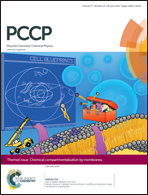An ‘all pigment’ model of excitation quenching in LHCII†
Abstract
The rapid, photoprotective down-regulation of plant light-harvesting in bright light proceeds via the non-photochemical quenching of chlorophyll excitation energy in the major photosystem II light-harvesting complex LHCII. However, there is currently no consensus regarding the precise mechanism by which excess energy is quenched. Current X-ray structures of this complex correspond to a dissipative conformation and therefore correct microscopic theoretical modelling should capture this property. Despite their accuracy in explaining the steady state spectroscopy of this complex, chlorophyll-only models (those that neglect the energetic role of carotenoids) do not explain the observed fluorescence quenching. To address this gap, we have used a combination of the semi-empirical MNDO-CAS-CI and the Transition Density Cube method to model all chlorophyll–carotenoid energy transfer pathways in the highly quenched LHCII X-ray structure. Our simulations reveal that the inclusion of carotenoids in this microscopic model results in profound excitation quenching, reducing the predicted excitation lifetime of the complex from 4 ns (chlorophyll-only) to 67 ps. The model indicates that energy dissipation proceeds via slow excitation transfer (>20 ps) from chlorophyll to the forbidden S1 excited state of the centrally bound lutein molecules followed by the rapid (∼10 ps) radiationless decay to the ground state, with the latter being assumed from experimental measurements of carotenoid excited state lifetimes. Violaxanthin and neoxanthin do not contribute to this quenching. This work presents the first all-pigment microscopic model of LHCII and the first attempt to capture the dissipative character of the known structure.


 Please wait while we load your content...
Please wait while we load your content...